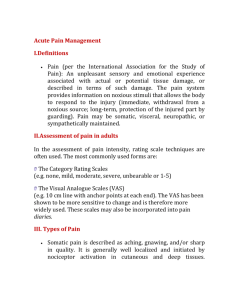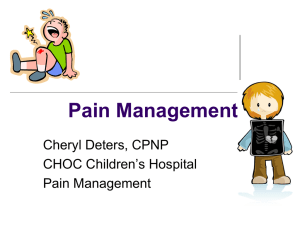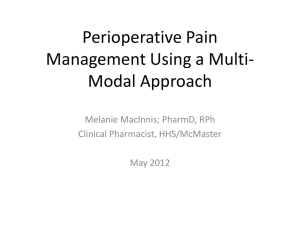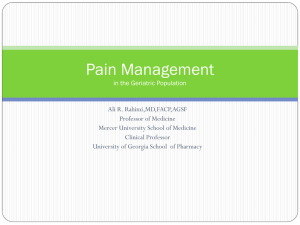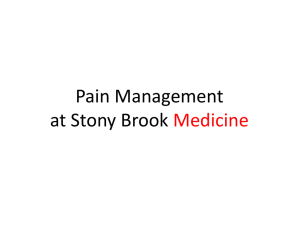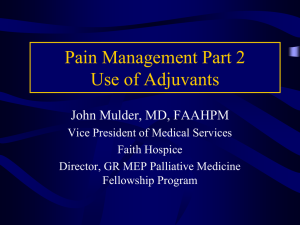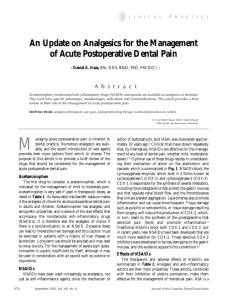Management of Pain in Operative by Opioid and
advertisement
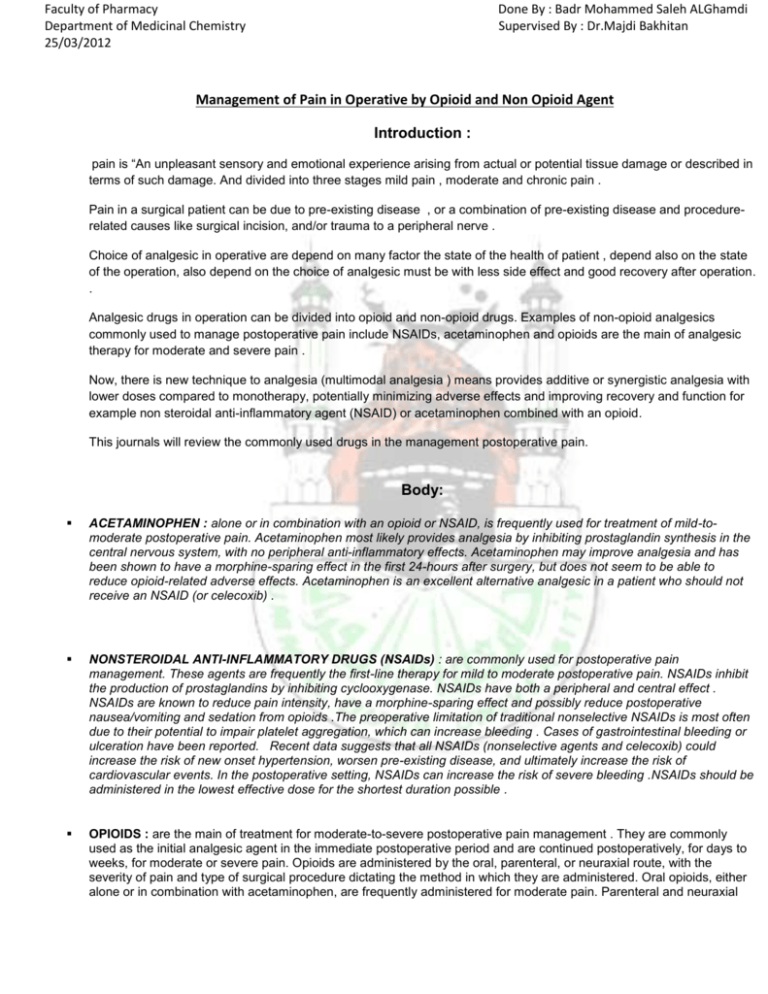
Faculty of Pharmacy Department of Medicinal Chemistry 25/03/2012 Done By : Badr Mohammed Saleh ALGhamdi Supervised By : Dr.Majdi Bakhitan Management of Pain in Operative by Opioid and Non Opioid Agent Introduction : pain is “An unpleasant sensory and emotional experience arising from actual or potential tissue damage or described in terms of such damage. And divided into three stages mild pain , moderate and chronic pain . Pain in a surgical patient can be due to pre-existing disease , or a combination of pre-existing disease and procedurerelated causes like surgical incision, and/or trauma to a peripheral nerve . Choice of analgesic in operative are depend on many factor the state of the health of patient , depend also on the state of the operation, also depend on the choice of analgesic must be with less side effect and good recovery after operation. . Analgesic drugs in operation can be divided into opioid and non-opioid drugs. Examples of non-opioid analgesics commonly used to manage postoperative pain include NSAIDs, acetaminophen and opioids are the main of analgesic therapy for moderate and severe pain . Now, there is new technique to analgesia (multimodal analgesia ) means provides additive or synergistic analgesia with lower doses compared to monotherapy, potentially minimizing adverse effects and improving recovery and function for example non steroidal anti-inflammatory agent (NSAID) or acetaminophen combined with an opioid. This journals will review the commonly used drugs in the management postoperative pain. Body: ACETAMINOPHEN : alone or in combination with an opioid or NSAID, is frequently used for treatment of mild-tomoderate postoperative pain. Acetaminophen most likely provides analgesia by inhibiting prostaglandin synthesis in the central nervous system, with no peripheral anti-inflammatory effects. Acetaminophen may improve analgesia and has been shown to have a morphine-sparing effect in the first 24-hours after surgery, but does not seem to be able to reduce opioid-related adverse effects. Acetaminophen is an excellent alternative analgesic in a patient who should not receive an NSAID (or celecoxib) . NONSTEROIDAL ANTI-INFLAMMATORY DRUGS (NSAIDs) : are commonly used for postoperative pain management. These agents are frequently the first-line therapy for mild to moderate postoperative pain. NSAIDs inhibit the production of prostaglandins by inhibiting cyclooxygenase. NSAIDs have both a peripheral and central effect . NSAIDs are known to reduce pain intensity, have a morphine-sparing effect and possibly reduce postoperative nausea/vomiting and sedation from opioids .The preoperative limitation of traditional nonselective NSAIDs is most often due to their potential to impair platelet aggregation, which can increase bleeding . Cases of gastrointestinal bleeding or ulceration have been reported. Recent data suggests that all NSAIDs (nonselective agents and celecoxib) could increase the risk of new onset hypertension, worsen pre-existing disease, and ultimately increase the risk of cardiovascular events. In the postoperative setting, NSAIDs can increase the risk of severe bleeding .NSAIDs should be administered in the lowest effective dose for the shortest duration possible . OPIOIDS : are the main of treatment for moderate-to-severe postoperative pain management . They are commonly used as the initial analgesic agent in the immediate postoperative period and are continued postoperatively, for days to weeks, for moderate or severe pain. Opioids are administered by the oral, parenteral, or neuraxial route, with the severity of pain and type of surgical procedure dictating the method in which they are administered. Oral opioids, either alone or in combination with acetaminophen, are frequently administered for moderate pain. Parenteral and neuraxial Faculty of Pharmacy Department of Medicinal Chemistry 25/03/2012 Done By : Badr Mohammed Saleh ALGhamdi Supervised By : Dr.Majdi Bakhitan opioids are usually administered for severe pain. Opioids exert their effects by binding to central opioid receptors. The activity of the specific opioid depends on the actual agent and how well it binds to a given opioid receptor. Unlike NSAIDs and local anesthetics, opioids do not interrupt nociceptive transmission but rather decrease the ability to discern pain . Opioids differ in potency, safety, and patient characteristics. Propoxyphene, codeine, and hydrocodone are less potent opioids that are used in combination with acetaminophen. These combination products are indicated for moderate pain. Higher doses of these opioids would be required to treat severe pain and would cause significant adverse effects for the patient, including acetaminophen overdose. Morphine, hydromorphone, and fentanyl are potent opioids that can be used alone in a dose that will treat moderate or severe pain. Oxycodone can be used for moderate or severe pain, depending upon the product formulation. When combined with acetaminophen or aspirin, the dose is limited by the amount of acetaminophen or aspirin in the product. Therefore, the dose of oxycodone needed to treat severe pain could not be provided with a combination product . Conclusion : State of health of patient important in choice of analgesic agent for example NSAIDs impair platelet aggregation and increase risk of bleeding , so should be avoided in cases of gastrointestinal bleeding or ulceration . Multimodal technique new method used mean used synergistic analgesia to reduce side effect . Acetaminophen used for treatment of mild-to-moderate postoperative pain and has been shown to have a morphine-sparing effect in the first 24-hours after surgery, but does not seem to be able to reduce opioid-related adverse effects. NSAIDs These agents are frequently the first-line therapy for mild to moderate postoperative pain , have a morphine-sparing effect and possibly reduce postoperative nausea/vomiting and sedation from opioids . Opioids are the mainstay of treatment for moderate-to-severe postoperative pain management . used as the initial analgesic agent in the immediate postoperative period and are continued postoperatively. Opioids differ in potency, safety, and patient characteristics , Propoxyphene, codeine, and hydrocodone are less potent opioids that are used in combination with acetaminophen for moderate pain , Morphine, hydromorphone, and fentanyl are potent opioids that can be used alone in a dose that will treat moderate or severe pain Oxycodone can be used for moderate or severe pain, depending upon the product formulation .
